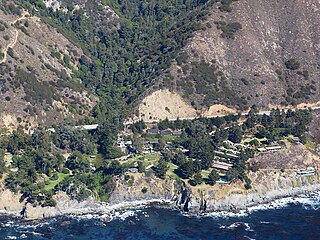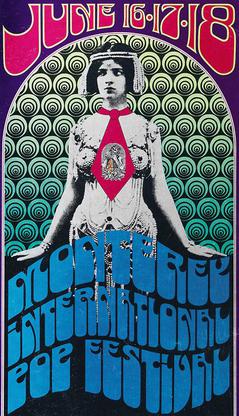
Joan Chandos Baez is an American singer, songwriter, musician, and activist. Her contemporary folk music often includes songs of protest and social justice. Baez has performed publicly for over 60 years, releasing more than 30 albums.

The Esalen Institute, commonly called Esalen, is a non-profit American retreat center and intentional community in Big Sur, California, which focuses on humanistic alternative education. The institute played a key role in the Human Potential Movement beginning in the 1960s. Its innovative use of encounter groups, a focus on the mind-body connection, and their ongoing experimentation in personal awareness introduced many ideas that later became mainstream.

The Monterey International Pop Festival was a three-day music festival held June 16 to 18, 1967, at the Monterey County Fairgrounds in Monterey, California. The festival is remembered for the first major American appearances by the Jimi Hendrix Experience, the Who and Ravi Shankar, the first large-scale public performance of Janis Joplin and the introduction of Otis Redding to a mass American audience.

Newport Folk Festival is an annual American folk-oriented music festival in Newport, Rhode Island, which began in 1959 as a counterpart to the Newport Jazz Festival. The festival was founded by music promoter and Jazz Festival founder George Wein, music manager Albert Grossman, and folk singers Pete Seeger, Theodore Bikel, and Oscar Brand. It was one of the first modern music festivals in America, and remains a focal point in the expanding genre of folk music. The festival was held in Newport annually from 1959 to 1969, except in 1961 and 1962, first at Freebody Park and then at Festival Field. In 1985, Wein revived the festival in Newport, where it has been held at Fort Adams State Park ever since.

The Winnipeg Folk Festival is a nonprofit charitable organization with an annual summer folk music festival held in Birds Hill Provincial Park, near Winnipeg, Manitoba, Canada. The festival features a variety of artists and music from around the world and is sure to include a number of local artists.

Margarita Mimi Baez Fariña was an American singer-songwriter and activist, the youngest of three daughters to a white mother and Mexican-American physicist Albert Baez. She was the younger sister of the singer and activist Joan Baez.

Richard George Fariña was an American folksinger, songwriter, poet and novelist.
Albert Vinicio Báez was a Mexican-American physicist and the father of singers Joan Baez and Mimi Fariña, and an uncle of John C. Baez. He made important contributions to the early development of X-ray microscopes, X-ray optics, and later X-ray telescopes.
Meagher Electronics was a Monterey, California, company which was founded in 1947 by Jim Meagher. It included a recording studio which recorded early demos for Joan Baez, her sister, Mimi Farina and her sister's husband, Richard Farina. The company also repaired all sorts of home entertainment equipment, focusing on professional and semi professional sound equipment and high end home systems. It had a huge, high warehouse space in which literally hundreds of old wooden console radios and phonographs dating back to the 1920s were stacked to the rafters. Meagher used to explain that these had been left by customers who chose not to pick them up instead of paying the repair estimate charges.
Tom Jans was an American folk singer-songwriter and guitarist from San Jose, California. He is perhaps best known for his song "Loving Arms", which was recorded initially by Kris Kristofferson and Rita Coolidge, and notably covered by Dobie Gray, Elvis Presley and Petula Clark.
"Sweet Sir Galahad" is a song written by Joan Baez that she famously performed at the Woodstock Festival in August 1969, after having debuted it during an appearance in a Season Three episode of The Smothers Brothers Comedy Hour, which aired on March 30, 1969. A recording of the song, first released as a single in late 1969, would lead off Baez's 1970 album One Day at a Time.

Festival is a 1967 American documentary film about the Newport Folk Festivals of the mid-1960’s, and the burgeoning counterculture movement of the era, written, produced, and directed by Murray Lerner.

The Bitter End is a 230-person capacity nightclub, coffeehouse and folk music venue in New York City's Greenwich Village. It opened in 1961 at 147 Bleecker Street under the auspices of owner Fred Weintraub. The club changed its name to The Other End in June 1975. However, after a few years the owners changed the club's name back to the more recognizable The Bitter End. It remains open under new ownership.
Celebration at Big Sur is a film of the 1969 Big Sur Folk Festival in Big Sur, California, featuring Crosby, Stills, Nash and Young, Joan Baez, Joni Mitchell and others.
David Paul Briggs is an American keyboardist, record producer, arranger, composer, and studio owner. Briggs is one of an elite core of Nashville studio musicians known as "the Nashville Cats" and has been featured in a major exhibition by the Country Music Hall of Fame in 2015. He played his first recording session at the age of 14 and has gone on to add keyboards to a plethora of pop, rock, and country artists, as well as recording hundreds of corporate commercials.

Live at the Isle of Wight 1970 is a combo CD/DVD live album by Canadian singer-songwriter Leonard Cohen. Released in October 2009, it is his nineteenth album. The album was recorded in 1970 at the Isle of Wight.

The Kent Stage is a 642-seat theater that was built in 1927 in Kent, Ohio, United States. Since 2002, it has been used as a performance venue for music, plays and film.
Kathleen Larisch and Carol McComb are American singers and instrumentalists, who performed together in the 1960s as Kathy and Carol. As a duo, they released an acclaimed 1965 folk song album on Elektra Records, before pursuing separate careers. They have reunited to perform together on several occasions in recent years.
The Vanguard Visionaries series is a collection of artist sampler albums released by Vanguard Records to celebrate the company's 60th anniversary.
Johanna Demetrakas is an American independent filmmaker and television director known for documentaries like Womanhouse and Right Out of History. She has worked as a professor at Cal Arts and USC.












